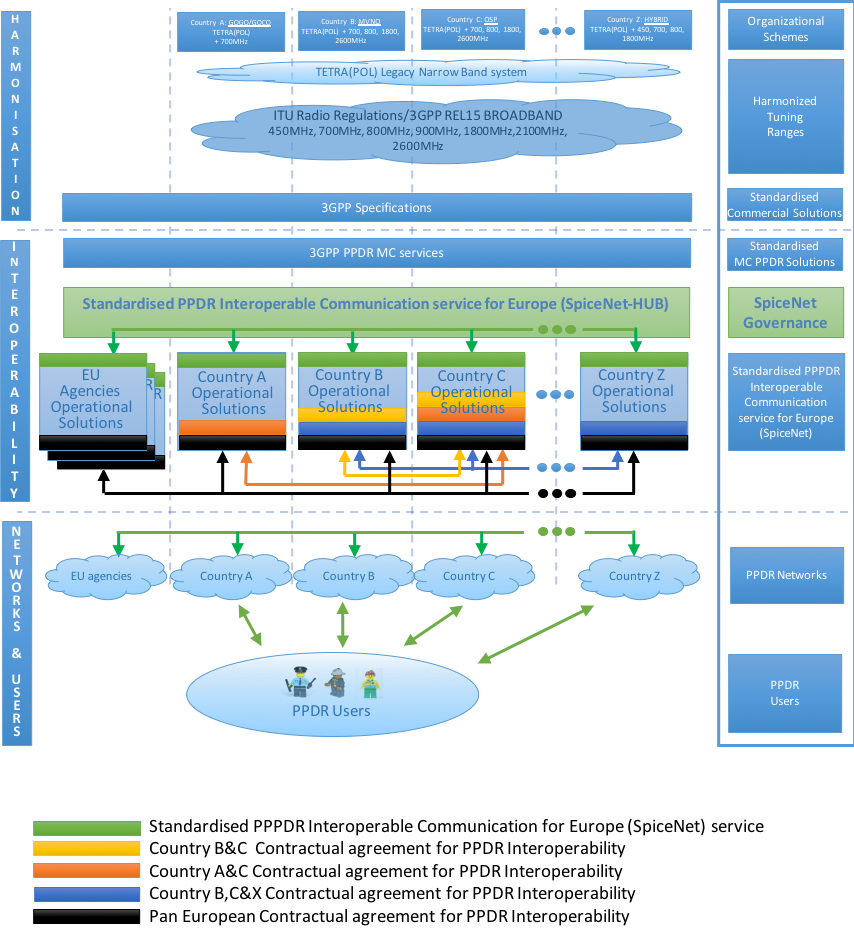SpiceNet Reference Architecture
A major aspect carried forward from BroadMap to BroadWay is the SpiceNet Architecture Reference. The Standardized PPDR Interoperable Communication Service for Europe (SpiceNet). The SpiceNet model proposes a reference architecture for harmonized pan-European PPDR mission critical broadband services which contains three layers:
- Harmonization
- Organizational schemes,
- Tuning ranges
- Standardized commercial solutions
- Interoperability and governance
- Standardised Mission Critical Solutions for public safety,
- SpiceNet governance
- Standardized PPDR Interoperable Communication for Europe (SpiceNet)
- Networks and users
- PPDR Networks,
- PPDR Users

The harmonisation layer has three components as follows:
Organizational schemes:
All European Countries are in different phases of the transition towards Mission Critical PPDR broadband services. Some countries have developed strategies, some have already started transition (e.g. UK) and some member states are still rolling out narrow band TETRA networks. Thus there is no common organisational scheme which can be used as a general solution. Organizational schemes can vary from dedicated networks and services to full MVNO services and to all combinations between hybrid and OSP (Outsourced Service Provider).
Harmonized tuning ranges:
All networks are based on standardised frequency bands. Depending on national regulations and service models, PPDR can use any combination of (450 MHz, 700 MHz, 800 MHz, 900 MHz, 1800 MHz, 2100 MHz and 2600 MHz) tuning ranges. Frequencies from standardised bands are also used for direct mode operation (proximity services) when networks are not available. During the transition period from legacy systems, narrow band digital PPDR radio networks can also be used.
Harmonised tuning ranges allow commercial devices to operate globally with all tuning ranges used by commercial operators. Chipsets and devices are manufactured based on 3GPP standards. This means that PPDR users can use SpiceNet services in any commercial network adopted for SpiceNet services.
Standardized commercial solutions:
All commercial mobile broadband networks, devices and some of the applications are based on 3GPP standards. This allows PPDR organisations to use or develop systems based on commercial off the shelf (COTS) solutions. COTS products are commercially available. By using networks based on 3GPP standards there will be a wide range of possibilities for PPDR users to benefit from all commercial innovations. However, PPDR specific needs of reliability, coverage and security must be guaranteed.Through standardization, for example international roaming has already been enabled for more than 20 years.
The interoperability layer has three components as follows:
Standardized MC PPDR solutions:
Mission Critical broadband services are now part of the commercial 3GPP standards. It is important to note that international roaming does not equate to PPDR cross-border interoperability. Current ongoing work of 3GPP enables a set of mission critical features and services. These PPDR-specific services form the foundation to enable versatile and interoperable solutions for PPDR organizations across Europe.
SpiceNet governance:
A pan-European governance function is needed to allow countries and agencies to use SpiceNet services. This function needs to be defined and appointed to some legal entity or organization at the EU level. In addition, each SpiceNet user organization must have a SpiceNet function, which consists of administration, finance, technology and security and maintenance functions.
A global agreement is needed for pan-European organisations to confirm governance above national legislations and in conformity with the current common regulations at the EU level.
Standardized PPDR Interoperable Communication for Europe (SpiceNet):
Due to cross-border interoperability and pan-European PPDR interoperability needs, a set of standardised, basic PPDR services must be defined. To establish these activities, and to maintain cross-border interoperability and preparedness, bi- tri- or multilateral cross-border agreements are also necessary.
Pan-European cooperation and interoperability is based on harmonised 3GPP tuning ranges and standardised infrastructure. Regardless of their location, PPDR users must be able to communicate based on agreements with other users and organizations in different MS’s. SpiceNet can provide MC services like for example MC PTT, MC Data, MC Video, status messaging, AVL, alerting, SDS messaging.
No matter the type of national organisation scheme employed, communication with any country and PPDR authority must be possible when the SpiceNet services are developed and established.
Validation and testing for SpiceNet services is mandatory in order to maintain interoperability in multi-vendor environment.
SpiceNet services are based on a distributed model where each country has their own service HUB (SpiceNet HUB), which includes business logic for all interoperability agreements related to each country. In addition to SpiceNet governance also bi-, tri- and multi-lateral interoperability functions shall be provided.
The Networks and Users layer has two components as follows:
PPDR networks:
The integration of SpiceNet services must be established by national network operators and service providers. Depending on organisational schemes, there are variations for implementing the services. More or less they are based on virtualized networks. Virtualization can have variations depending on the level of integration.
PPDR users:
Depending on agreed user specified SpiceNet services, PPDR end users will be able to communicate, using their devices, with PPDR users within their own country and across borders, assuming local PPDR Mission Critical broadband service availability.
Next generation PPDR Mission Critical broadband services allow new possibilities for all authorities to develop new ways of European cooperation on all levels. This means benefiting from new technology innovations for all areas of PPDR operations to improve efficiency and situational awareness, e.g. augmented reality, sensors, video, robotics, smart clothing, etc. The new technology will offer opportunities to use real time translation of spoken language (SpiceNet translator).
Non-technical governance and operational issues (see SpiceNet governance above) must be solved together with neighbouring countries and other organizations to enable cooperation.
In addition, each European agency (e.g. Frontex, Europol, civil protection mechanism) have their own operational solutions.
The SpiceNet model has been developed based on following key principles:
- The SpiceNet service allows PPDR users to use pan-European Interoperability/Cross-Country Interoperability/Domestic Inter-Agency Interoperability, based on availability of Mission Critical Broadband networks
- Each country uses their own national roadmap to implement the next generation Mission Critical Broadband Services in their country
- Each country uses their individual schedule to ramp down use of Legacy PPDR Radio Communication Systems
- There is a broad mixture of Organisational Schemes across countries (dedicated, MVNO, Hybrid etc.). SpiceNet is Organisation Scheme independent.
- Harmonized tuning ranges based on 3GPP frequency bands exist for any dedicated and commercial spectrum.
- All networks, terminals and features are based on 3GPP standardisation.
- Supported services could vary across countries and managed network operators based on the system supplier and their supported features and releases.
- International Roaming for almost all commercial services has been available more than 20 years. Cross country interoperability for PPDR services is not synonym for international roaming.
- A set of common MC services interoperability (SpiceNet-services) is necessary to ensure pan-European PPDR co-operation based on 3GPP Mission Critical specifications.
- Cross country/pan-European Interoperability can be implemented by mutual bi-lateral and multilateral agreements between MS Countries/PPDR organizations/pan-European organizations (e.g. Frontex, Europol, etc.). The SpiceNet model can be used as reference architecture to provide the interoperability.
As 3GPP standards and SpiceNet reference architecture are the platform for European interoperable broadband for PPDR, innovative solutions are required to improve PPDR field operations and processes e.g. on preventing terrorism, illegal immigration, human trafficking, surveillance, natural disasters, big traffic accidents, observation and vital data transmission as well as “on the fly” interpretation as examples.
